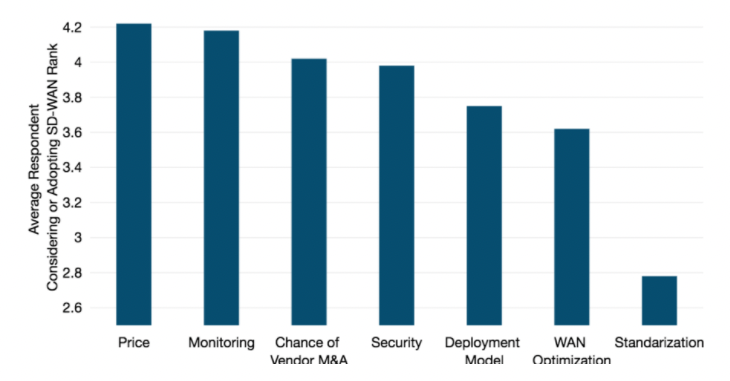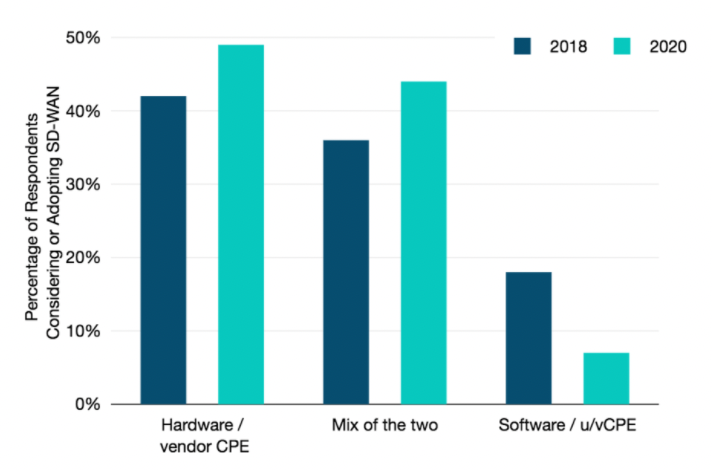The landscape for SD-WAN vendors is vast. While the core features of SD-WAN are generally consistent, vendors vary on additional features, security, deployment models, and pricing structures.
Our SD-WAN Research Service details the different service features and pricing available across SD-WAN vendors.
SD-WAN is officially a key component of modern enterprise WANs. As such, industry organizations like MEF have developed a standard definition for the technology and technical forums that are sorting out issues of interoperability. (We talked with Marc Cohn about this a few months back.)
The core benefits associated with SD-WAN technology are consistent across all provider offerings:
- Reduced cost and network complexity
- Ease of upgrades and policy changes
- Increased flexibility and network performance
As the standardization push continues, how vendors distinguish themselves in the market has changed. Simply offering SD-WAN has lost its competitive edge—the value now lies in the intelligence and service features that are being added to the service.
What a WAN Manager Wants
We’ve identified a host of features that customers take into account when selecting an SD-WAN service (and, surprisingly, the top of the list hasn’t seen many changes).
The chart below highlights the features WAN managers ranked as most important when selecting their SD-WAN vendor.
Competitive pricing and monitoring features rank highest in vendor selection. Vendor longevity or chance of M&A—the latter of which was a new addition to the list—came in third.
Security, which has become an increasingly important part of the SD-WAN discussion, follows closely behind. Deployment model and WAN optimization features rank next, trailed by standardization.
Reasons for Selecting an SD-WAN Vendor, 2020

It's worth taking a deeper dive into these service features, examining how they differ by provider and contribute to the cost of an SD-WAN overlay.
We’ve limited the data set to SD-WAN suppliers that provide a service via their own proprietary technology. (This section excludes service providers that offer managed SD-WAN service via partnership with another vendor.)
Deployment Models
Customers can deploy SD-WAN in one of two ways: as a software suite or as a combination of hardware and software supplied by the vendor.
Almost all SD-WAN vendors report offering both software and hardware deployment models, giving customers the freedom to select the option that best fits their preference.
The figure below highlights how WAN Manager Survey respondents opted to deploy the service.
Forty-nine percent indicated they already had or planned to install a hardware-based SD-WAN solution (up from 42% in 2018). Putting in place a mix of both SD-WAN hardware and software or uCPE followed, at 44%. This is an increase for both service options from previous surveys. A purely software-based approach remained least popular, at only 7%, a decrease from 18% in 2018.
SD-WAN CPE Selected, 2018 vs. 2020

The decreased interest in a purely software-based approach is a bit surprising. Particularly since one of the key points of emphasis of next generation SD-WAN services is virtualization and the process of moving away from physical appliances at network sites.
This, coupled with the increase in end-users opting for a hardware/software mix, suggests that enterprises may be looking for an approach that will enable them to select the best method for each individual site, rather than removing appliances across the network as a whole.
Regardless of CPE employed, for most SD-WAN vendors the hardware itself is usually not the differentiating factor. It’s the software running on it that captures most of the intelligence in the system.
You can explore all of TeleGeography’s WAN content over here.
Elizabeth Thorne
Elizabeth Thorne was formerly a Senior Research Analyst at TeleGeography. Her work was focused on enterprise network research.

